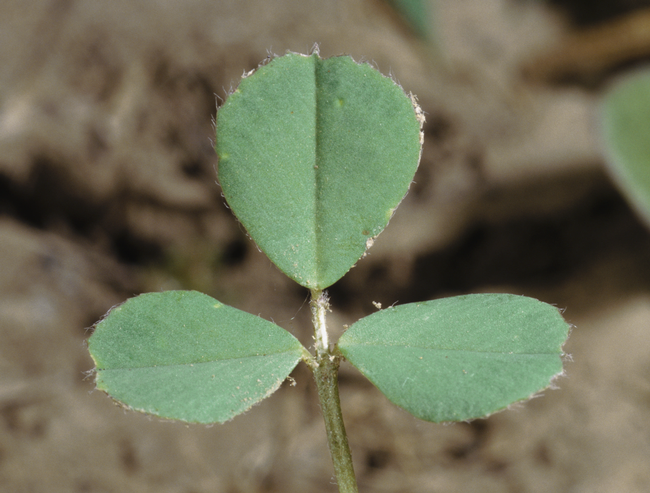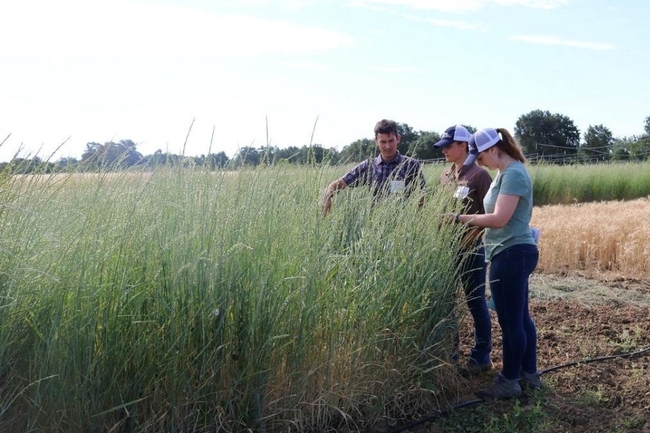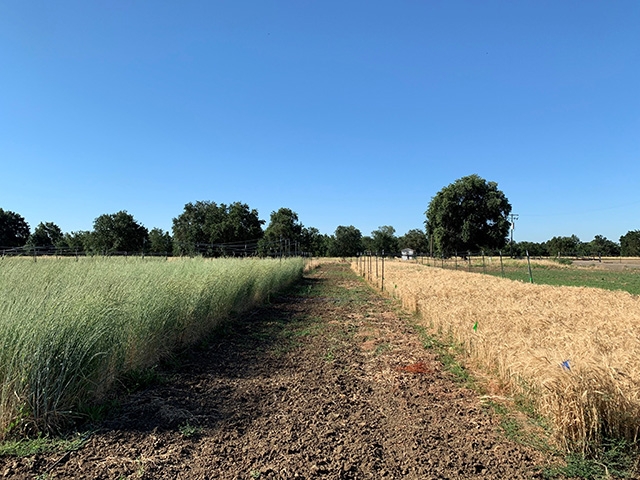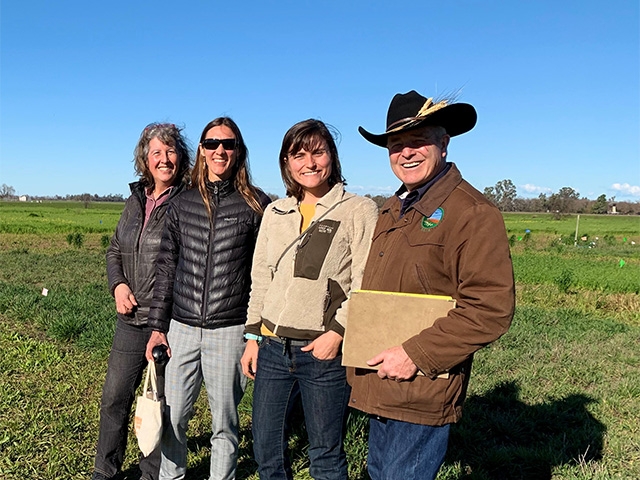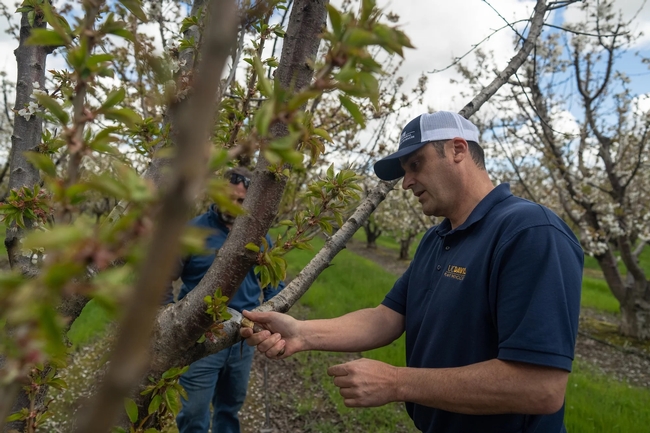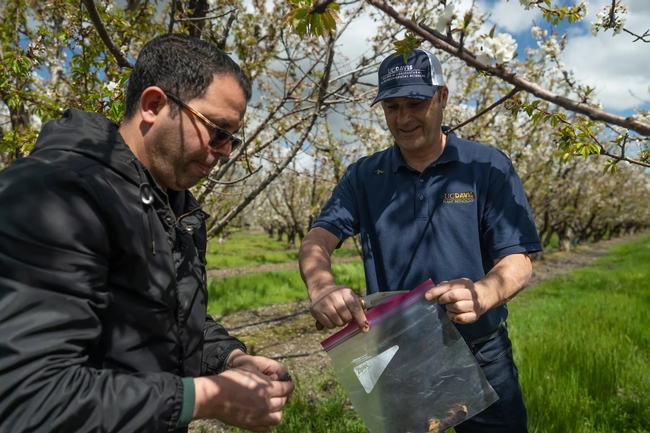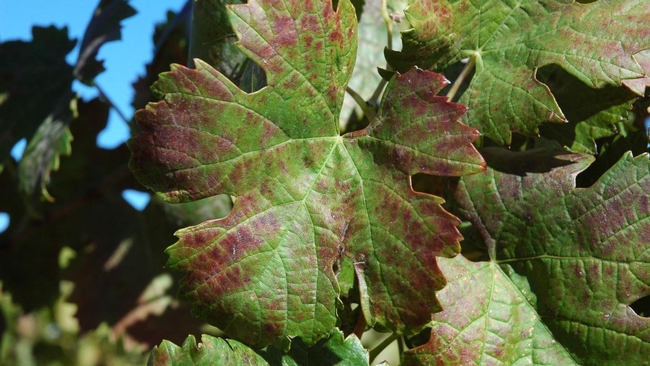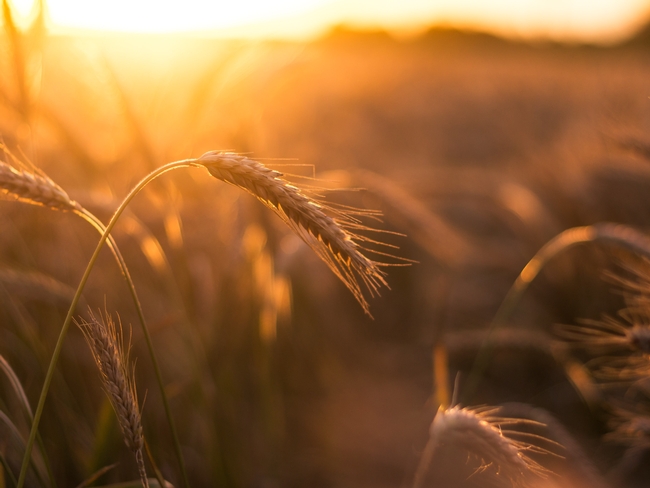Posts Tagged: plant
California Plant and Soil Conference set for Feb. 6-7 in Fresno
The 2024 California Plant and Soil Conference will be held Feb. 6-7 at the DoubleTree Hotel in Fresno. The conference is organized by the California Chapter of the American Society of Agronomy and UC Cooperative Extension.
This year's conference will cover the following topics:
- Are we ready? Adapting agronomy to an uncertain future
- Precision agriculture
- Nutrient management
- Micronutrients
- Animal-plant systems management
- Soil management
- California IPM toolbox
- Pesticide resistance
- Bees, pollinators
- Groundwater recharge
- On-farm water management
“The diverse topics covered at the annual California Plant and Soil Conference are determined by polling members each year about what information is most important for them to learn about regarding sustainable agricultural production in California,” said Nicholas Clark, conference organizer and UC Cooperative Extension farm advisor, who specializes in agronomy and nutrient management.
Growers, pest control advisers and crop consultants, allied ag industry professionals, academics, and government agency staff attend this accessible, science-based conference each year to stay up-to-date on major issues in California agriculture and their potential solutions. In addition to networking opportunities, the conference offers continuing education credits for growers and other ag professionals seeking to maintain various licenses.
“Another really cool thing about this conference is that the chapter has a strong career development component to it,” said Clark. “We support students through financial assistance to attend as poster presenters, and we give monetary awards to student poster contest winners judged by members of the CA ASA board and industry professionals. We also have a merit-based scholarship award given to students each year for their contributions to and potential in the agricultural industry and science fields. These awards are largely supported by private sponsors and member dues.”
The annual conference provides an opportunity for all attendees to increase their knowledge of current topics of agronomic importance in California. By attending the conference, certified crop advisers and pest control advisers can earn continuing education units that are important to their professional standing.
The agenda for the conference includes several new items this year:
- Two additional sessions with six speakers will be offered on the afternoon of Feb. 7 after the business lunch.
- A student-mentor breakfast meeting will be held the morning of Feb. 7 with round-table discussions to hear about mentors' experiences and career paths in agricultural science fields, providing a chance to network and broaden perspectives.
In addition to presentations, there will be an award ceremony to honor individuals who served the profession through their careers, a student poster competition, non-competitive professional posters, and the CA ASA business meeting. Sponsorship opportunities are available to support student participation. For more information, please see the conference website at https://na.eventscloud.com/website/58588/sponsors.
Registration is $375. Early bird registration is $325 and ends Jan. 12. Registration on site will be $425. Register through the conference website: https://na.eventscloud.com/plantandsoilconference.
The conference is planned and presented by a team of volunteer professional agronomists from research institutions, UC Cooperative Extension, public agencies and private companies. If you are interested in serving on the board or have questions about the conference, please contact a current board member (https://na.eventscloud.com/website/58588/leadership).
The California Chapter of the American Society of Agronomy was founded in April 1971 by a group of California agronomists who recognized the value in creating a forum to focus on California agriculture. The purpose of the annual meeting is to promote research, disseminate scientific information, foster high standards of educational and ethical conduct in the profession, and facilitate robust cooperation among organizations with similar missions.
No-till annual wheat better for soil health in California’s climate
One more reason to adopt sustainable cultivation
California wheat farmers could both maintain their yields and improve soil health by growing annual wheat without tilling the soil year after year.
This could be one more encouragement to farmers to adopt a sustainable practice commonly called conservation tillage, no-till or minimum-till cultivation, impacting how we grow a grain that supplies about 20 percent of the calories and protein for people around the world.
A new study, by a team led by Mark Lundy, University of California Cooperative Extension specialist in UC Davis' Department of Plant Sciences, offers new insight for decades-long discussions around soil conservation, sustainable agriculture and climate-warming emissions related to growing our food. The study has been published in the journal Soil and Tillage Research. For the first time, researchers have shown that annual wheat that is not tilled each year is better for stashing carbon in the soil than perennial wheatgrass, while still yielding more crop in Central California.
Previous studies have looked at annual wheat that is tilled each year, annual wheat that is not tilled, and a cousin species, perennial intermediate wheatgrass (trademarked Kernza), which also is not tilled. But until now, no one has looked at all of the benefits and trade-offs together. Most importantly, “no one has ever controlled for tillage,” Lundy said. “And, no one has compared annual wheat to perennial intermediate wheatgrass over multiple years in a Mediterranean climate, which is what we have in California.”
This study also is unique because it delves into the deeper question of what is going on in the soil that drives the different results for carbon there. Soil carbon reflects various processes linked to plant activity and soil health. Measuring the different forms of soil carbon may also signal whether a farming system is accumulating carbon in the soil over time – a plus for reducing climate-warming gases in the atmosphere.
“Measuring soil carbon is complex and nuanced,” said Kalyn Taylor, the lead author on the paper. “We started this experiment because we wanted to know whether and how plant activity and tilling or not tilling would affect the carbon story belowground in California's climate.”
“When we started this study, we thought the crop being perennial or annual would drive the differences in carbon storage in the soil,” Lundy added. Specifically, they had expected perennial wheatgrass would lead to more carbon in the soil because of its deeper, better-established root system. “But that's not what we found,” he went on. “What we found was, it was the lack of tillage, plus the level of productivity of common annual wheat, that made the difference in soil carbon here in California.”
Soil carbon in annual vs. perennial grain
In 2017, Lundy, then-graduate-student Taylor, UC Davis Professor Emeritus Kate Scow and others on the team started measuring different forms of soil carbon in test plots at Russell Ranch, west of campus. Plots were planted with annual wheat that was tilled each spring, annual wheat that was not tilled and perennial intermediate wheatgrass (Kernza) that also was not tilled.
Each year, the researchers measured the carbon present in the soil, the amount of soil organisms (which have carbon in their bodies) and the amount of material the plants created.
At the end of three growing seasons, they found that land planted with no-till, common, annual wheat had the highest amount of soil organisms, measured as biomass, of the three treatments.
The researchers also found soil carbon is more likely to remain stable in the no-till, annual plots, compared to both tilled wheat and wheatgrass.
In addition, the no-till, annual wheat produced plant material more consistently than the perennial wheatgrass across the three years, which saw variation in rainfall.
“Overall, annual wheat grown without soil disturbance or tillage had both higher productivity and higher potential for storing carbon in the topsoil than perennial wheatgrass in our Mediterranean climate,” Lundy said.
Related research
“No-till annual wheat increases plant productivity, soil microbial biomass, and soil carbon stabilization relative to intermediate wheatgrass in a Mediterranean climate,” is online now and will be published in the January 2024 edition of Soil and Tillage Research.
The team also found that tilled annual wheat vs. Kernza stores total carbon at different depths in the soil profile and hosts distinct soil fungal communities, primarily in the root zone and topsoil: Taylor, K., Samaddar, S., Schmidt, R., Lundy, M. and Scow, K., 2023. Soil carbon storage and compositional responses of soil microbial communities under perennial grain IWG vs. annual wheat. Soil Biology and Biochemistry, p.109111.
Previous work comparing the perennial grain known as intermediate wheatgrass (trademarked Kernza) to annual wheat had not distinguished the extent to which soil health benefits are a function of the perennial nature of the crop. Read the story here.
This story was originally published on the UC Davis News site.
Winter atmospheric rivers gave pathogens, diseases path to infect crops
Outbreaks similar to El Niño-influenced issues of the 1990s
The wave of atmospheric rivers that swept across the state this winter has created the right conditions for plant pathogens that haven't been seen for decades in California. University of California, Davis, plant pathologist Florent “Flo” Trouillas is getting more calls from growers and farm advisors concerned about potential crop damage.
“Generally, whenever you have rain events, you're going to have problems,” said Trouillas, a Cooperative Extension specialist who is based at the Kearney Agricultural Research and Extension Center in Parlier. “In wet years we get really busy because most pathogens need and like water.”
Trouillas is like a disease detective. He splits his time between the field and the lab, working to diagnose pathogens, diseases and other ailments that strike fruit and nut crops such as almonds, cherries, olives and pistachios.
On a recent visit to an almond orchard near Fresno, Trouillas joined Mae Culumber, a nut crops farm advisor for UC Cooperative Extension Fresno County. A few weeks earlier, the two had walked the orchard, taking note of the base of some trees that had gumming — a thick, jelly-looking substance indicating a pathogen had taken hold.
“A lot of what Florent is doing is trying to assess patterns on a landscape,” Culumber said. “Sometimes things may look like they are one thing, but it could be another problem.”
When the two returned weeks later, the amber-colored gumming had moved into the canopy, looking like gumballs stuck to branches, some of which were already dead. “It's getting out of control from before,” Trouillas says. “This branch was killed. This is widespread.”
From the field to the lab
Lab testing confirmed what Trouillas believed was the culprit: Phytophthora syringae, a pathogen that can affect almond crops but is rarely seen in California. If it is found, generally the site of infection are wounds caused by pruning, but that is not the case here, where the infection began in the canopy at twigs, or small branches.
It is a threat to a key crop, which according to the California Department of Food and Agriculture, generates $5 billion annually. The last time Phytophthora syringae hit California was in the 1990s after a series of El Niño-influenced storms. Trouillas, who has a photographic memory, remembered reading about it in an old manual.
“It's rare for California and one that we see mostly following atmospheric rivers,” he says.
“The disease will only happen following these extremely wet winters.”
Phytophthora is soilborne, mostly found in tree roots, and doesn't generally spread up into branches. But the intense storms created the right conditions for the pathogen to “swim” up trunks as winds blew spores into the air and rain dropped them back down into the canopy, Trouillas said.
Some of the trees in this orchard will die; others can be saved by pruning infected branches and applying a recommended fungicide, he said.
Identification, diagnosis, education
Trouillas is one of more than 50 Cooperative Extension specialists at UC Davis and each is charged with identifying problems and developing solutions for those issues in support of agriculture, the ecosystem and communities throughout the state.
In his role, Trouillas focuses not only on pathology and research but also on educating growers, nursery staff, pest control advisers and others in agriculture about ways to manage potential threats and how to prevent crop damage.
“His role is very crucial,” said Mohammad Yaghmour, an orchard systems advisor for UC Cooperative Extension Kern County. “He's not only on this mission to educate growers but he's also a source of education for us.”
Trouillas typically conducts one or two site visits a week, usually after a farm advisor reaches out about a problem they can't solve on their own.
“This allows us to be at the forefront of disease detections in California,” he said.
He likens these visits to house calls a doctor would make, only to fields instead. And one of those calls recently took him to a cherry orchard in Lodi.
“These guys help me quite a bit,” said Andrew Vignolo, a pest control adviser with Wilbur-Ellis who asked for a consult. “I bug them a lot.”
The visit starts like any consult in a doctor's office, only the questions come fast as they walk around the Lodi orchard where branches are dying, there is gumming and the trees appear stressed. Some look to be sunburned from exposure. Old pruning wounds show cankers, indicating that past disease treatments didn't get rid of whatever was affecting the trees.
Trouillas asks about the cultivar of the trees because some varieties are more susceptible to pests or diseases. He focuses on stress because that opens the door to disease.
Do they prune in the dormant winter months or in summer when pathogens are more prevalent? Does the soil get tested? How old are the trees? What about nutrition?
“I'm trying to figure out how they got infected so bad,” Trouillas said, walking the orchard. “Bacterial canker is a very mysterious disease.”
He thinks it might be a bacterial canker disease and shaves some bark to take to the lab for testing. He wants to come back next winter to take some samples to see where the pathogen is overwintering.
“We'll know in a few weeks if we have a fighting chance,” Vignolo said.
Be it Lodi, Fresno or elsewhere in the state, Trouillas focuses on local conditions. But what is learned in one field can be passed on to others, providing early warnings or advice for those in similar situations. “All these efforts at collaboration, from the field, to the lab, going through research projects, there's only one goal here — to help the farmers of California.”
UC Davis to build new $5.25M greenhouse to protect U.S. grapevine collection
Project designed to prevent red blotch and other grapevine diseases
A new, $5.25 million greenhouse is being built on the University of California, Davis, campus to safeguard an important grapevine collection from red blotch disease and other pathogens.
The 14,400-square-foot greenhouse will have a vestibuled entry, be insect-proof and provide another level of disease protection. It is being spearheaded by Foundation Plant Services, or FPS, which provides the U.S. grape industry with high-quality, virus-tested grapevine plant material.
The program serves as the primary source for grapevine plant material distributed to nurseries under the California Department of Agriculture's Grapevine Registration and Certification Program, which provides the majority of grapevines planted in the United States. For the grape industry, it is essential to protect this material from disease-carrying insects and guarantee fast access to clean plant material.
“The program is considered the largest quarantine center for the grapevine industry in the United States,” said Maher Al Rwahnih, a plant pathologist and FPS director. “This is kind of a game changer for us.”
A history of serving the grapevine industry
FPS has maintained healthy grapevine planting stock on the UC Davis campus for more than 70 years in open fields at the Classic and Russell Ranch foundation vineyards. FPS scientists first detected grapevine red blotch virus at Russell Ranch in 2017. By 2021, an estimated 51.6% of the crop there was infected. Material from that vineyard is not being sold, and the site is now part of an epidemiological study to try to pinpoint how the disease is transmitted.
FPS pathologists have detected red blotch on less than 1% of the Classic vineyard crop. But it may not always be that way in the future.
“We don't know how long the Classic vineyard will remain clean,” Al Rwahnih said. “Every testing season, this is what keeps me up at night. We're not sure why it's happening in Russell Ranch and not the Classic vineyard.”
Once the greenhouse is operating, grapevines propagated from plant material from the Classic vineyard will be moved into the greenhouse, tested and verified as clean from disease. From there it will be sold to nurseries, which will grow additional plants to sell to growers.
Two greenhouses part of plan
Normally the foundation has 4,000 vines available, but the greenhouse will only house 2,000 vines, so inventory will be cut in half.
“This phase is just a starting phase,” Al Rwahnih said. “It's not sufficient for our needs.”
FPS plans to build another greenhouse in the next two to three years to increase capacity.
Industry groups and FPS identified greenhouses as the best way to protect the plants from red blotch and other pathogens transmitted by insects. They are also consulting with those same people on the grape varieties to include in the greenhouse.
“We have a large selection, and we need to make sure all the varieties that are important to industry are contained,” he said.
The first greenhouse is expected to be finished by the end of 2023.
Funding for the first greenhouse is coming from a variety of sources. The California Fruit Tree, Nut Tree and Grapevine Improvement Advisory Board, managed by the California Department of Food and Agriculture, contributed $4 million to the project. The California Grape Rootstock Research Foundation gave $500,000, Foundation Plant Services with UC Davis is funding $450,000, and the California Grape Rootstock Commission gave $100,000.
“This is crucial for the grapevine industry, and we are very grateful for the support,” Al Rwahnih said.
UC Davis to lead $15 million research into climate-change resistant wheat
The project will also train plant breeders for the future
Wheat products account for roughly 20% of what people eat every day around the globe. As climate changes, wheat crops must adapt to new weather patterns to keep up with demand.
The University of California, Davis, is leading a five-year, $15 million research project to accelerate wheat breeding to meet those new climate realities, as well as to train a new generation of plant breeders.
“Everything is less stable,” said Jorge Dubcovsky, a plant sciences distinguished professor who is leading the grant research. “Everything is changing so you need to be fast. You need to be able to adapt fast.”
The grant from the U.S. Department of Agriculture's National Institute of Food and Agriculture will create a coordinated consortium of 41 wheat breeders and researchers from 22 institutions in 20 states. Researchers from Mexico and the United Kingdom are also participating.
Breeding needs to speed up
“Breeding crops for the future will require new traits, breeding platforms built for quick transfer of traits to elite cultivars, coordination of breeding efforts in public and private domains, and training for current and future plant breeders and researchers,” NIFA said in an announcement about this grant and others related to breeding.
The program involves on-the-ground research, identifying molecular markers and data analysis from multiple institutions to determine genes that will help wheat crops mitigate the effects of climate change. Plant breeding will follow to prove out those findings.
Wheat is unlike other crops in that 60% of the plant varieties — generating about $4 billion in annual production — are developed by public breeding programs rather than private corporations. In many states, wheat growers tax themselves to support basic breeding efforts at public institutions like UC Davis.
Increased coordinated research
The NIFA grant money will lead to more coordinated, sophisticated research. “This grant allows us to do breeding at a level that a good, modern company would do,” Dubcovsky said. “This grant is essential to maintain modern and effective public breeding programs in the U.S.”
The consortium will bring together data and research from across institutions, allowing for more expansive analysis while reducing redundancies. “We can take advantage of the data from everybody,” he said. “By doing that we don't need to duplicate efforts.”
A team in Texas will analyze plant images taken from drones at each institution to extract information about plant growth, water use, nitrogen levels and other data. “Using technology, we can see beyond our human capabilities,” Dubcovsky said. “You can extract a huge amount of information from every plant variety.”
The data from those images will allow researchers to document the plants throughout the life cycle and determine which plants fare better under certain conditions. Genotyping will help researchers obtain information about the plant genome. The combination of these two types of data could speed up breeding cycles, helping wheat crops adapt to a changing environment.
“If we can breed fast, we can adapt to change,” Dubcovsky said. “We are trying to make sustainable improvements in time.”
Training the next generation
The project will also train a cohort of 20 plant Ph.D. students in active breeding programs where they will participate in fieldwork, collect data from drones and DNA samples, and learn to integrate that information to accelerate wheat breeding. The students will participate in online and face-to-face workshops, as well as educational events and national scientific conferences.
Colorado State University, Cornell University, Kansas State University, Michigan State University, Montana State University, Oklahoma State University, Purdue University, South Dakota State University, Texas A&M University, University of Idaho, University of Illinois, University of Minnesota, University of Nebraska, University of Wisconsin, Utah State University, Virginia Tech, Washington State University, and U.S. Department of Agriculture Agricultural Research Service branches in North Dakota, Washington, Kansas and North Carolina are also participating in the consortium.


